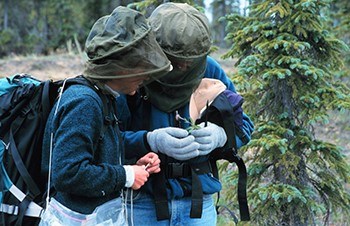
NPS/Josh Foreman
Beringia's most prominent geological feature is the land bridge that formed intermittently during the 2.5 million years of Pleistocene glacial and interglacial cycles. In a glacial period, vast amounts water were locked in continental ice sheets 2 km to 4 km thick at their summits. With this much water on the planet stored as ice, sea level dropped enough for a land connection to emerge between Asia and North America. The most recent land bridge occurred during the Last Glacial Maximum, which peaked near the end of the Ice Age (approximately 20,000 years ago).. While the majority of arctic lands around the globe were covered with thick glaciers, most of Beringia was cold, dry, and ice-free. The huge size of the land bridge has prompted many scientists to classify it as a now-vanished subcontinent. Some have posited this was largely a steppe environment much like modern Siberia. More recently, evidence from sediment cores drilled into the now submerged Beringia landscape indicate the land bridge was ecologically diverse, with patches of shrub tundra similar to modern Arctic Alaska, interspersed with grasses and highly nutritious flowering plants known as forbs.
Modern Beringia is a land of great physical diversity, including mountain ranges, rolling lowlands, large lakes of volcanic origin, large sounds and lagoons, hot springs, and lava beds. The breathtaking landscapes feature ancient broad valleys and tundra, abundant lakes, winding streams, tors (granitic towers formed deep underground and now exposed), and permafrost. Ocean waves have formed sand spits with distinctive beach ridges and sea cliffs along the coastline, although sea cliffs are more common on the Chukotkan Peninsula than on Alaska's coastline.
The most recent land bridge was a genetic mixing zone for plants and animals. Humans that migrated to the land bridge became isolated from their Asian ancestor populations, probably due to the cold, harsh glacial climate, and eventually went on to populate the Americas. Swedish botanist Eric Hulten was the first to notice that the range of distribution of vascular plants was in the shape of concentric ovals elongated in a west-east direction with the access of symmetry going directly through Bering Strait.
Chukotka and Northwest Alaska have many ecological similarities although Northwest Alaska became considerably more maritime than the still-continental climate of Russia. Both regions support rich and diverse floras of vascular and nonvascular plants and a broad suite of large mammals. Permafrost and tephra (volcanic ash) from the Devil Mountain maar lakes explosion helped preserve intact a layer of decaying, frozen plants from the land bridge times. Today's Beringia tundra on both sides of the strait is abundant with sedges, peat mosses, lichens, grasses, heaths, willows, and alders. During the short summers the rolling landscape brightens with lustrously blooming flowers, such as fireweed, arctic rhododendron, moss campion, alpine azalea, mountain avens, gentians, monkshood, lousewort, asters, cotton grass, heathers, and others. Even more numerous are the hundreds of lichen species covering the tundra and frequently creating yellow patterns visible from aircraft.
Historically, Beringia is famous for its megafauna – giant animals, such as woolly mammoth, mastodon, arctic camel, scimitar cat, giant beaver, Jefferson ground sloth, bison, and others. Many areas on the modern Chukotkan and Seward peninsulas have abundant bird populations with at least 170 species known on the Seward Peninsula. Both sides are home for large populations of migratory geese, ducks, sandhill cranes, and shorebirds. Colonies of seabirds are found on both coasts.
Contemporary land animals, represented by populations of brown bears, wolves, wolverine, red fox, land otters, lynx, arctic ground squirrels, arctic hares, and numerous small mammals, are found throughout both peninsulas. Large marine mammals, such as whales, walruses, seals, and polar bears have been the most important component of the subsistence lifestyle of Native populations on both sides of the Bering Strait. Northwest Alaska is also home to musk oxen, caribou, Dall sheep, moose, and black bears.
Modern Beringia provides a wealth of research materials and great opportunities for scientists to study and explore past, present, and future environments. Researchers conduct studies on present day plants and animals, as well as extinct plants and animals of the last Ice Age and other paleo-environments. These studies and the monitoring of current vegetation, wildlife, and environmental conditions can place in a broader timeframe the fluctuations in population, climate change, and subsistence use by rural Alaska Residents. Research being conducted to look at past environments and the people and wildlife that lived there helps to create a picture of what life was like and reconstruct the picture of the vanished landscapes of Beringia.
If you want to learn more about the current scientific research in the Arctic network of U.S. national parks that encompasses Bering Land Bridge National Preserve, Cape Krusenstern National Monument, Noatak National Preserve, Kobuk Valley National Park, and Gates of the Arctic National Park and Preserve, please visit the Arctic Network Inventory and Monitoring Program website.
Last updated: March 14, 2022
